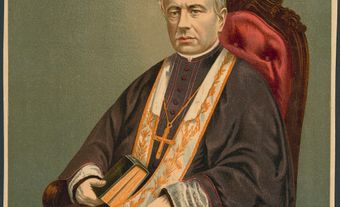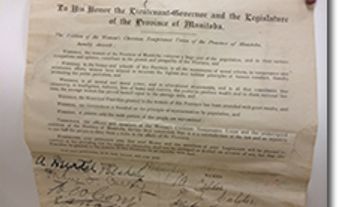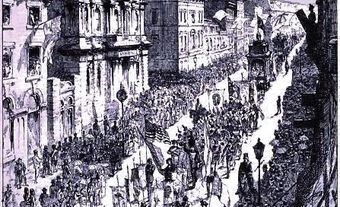
Defining Elements
Antifeminism is opposed to the emancipation of women. However, unlike widespread attitudes and behaviours such as misogyny (the hatred of women), machismo (a traditional view of men as very strong and aggressive) and sexism (the division of humankind into two complementary genders, the feminine being considered inferior to the masculine), antifeminism is more reasoned and organized. Antifeminism takes the form of a counter-movement that impedes the women’s movement. Institutional actors (in the form of state antifeminism or systemic antifeminism), intellectuals and activist organizations are all participants in antifeminism.
Antifeminism spans different schools of thought and includes multiple collective identities and ideologies. Because of its imitative quality, antifeminism evolves and changes in response to advances made by the women’s movement with which it is in conflict. As a result, the strain of antifeminism that fought against the vote for women in Canada (see Women’s Suffrage) is different from the antifeminism of the 1980s. The antifeminism of the 1980s, known as “masculinism” (although a number of its proponents rejected the term, preferring to speak of “fathers’ rights” or “hominism”), was organized around groups for separated and divorced fathers. In contrast to the unabashed anti-suffragism of Henri Bourassa — who called for the submission of French Canadian Catholic women in the face of the Protestant threat — the type of antifeminism that reconfigured in the late 1970s and early 1980s was more subtle. It stressed the idea that feminism created various problems for men. As well, owing to societal changes in Québec and gains for women won by the feminist movement, proponents of masculinist antifeminism no longer openly demanded that women be confined to the roles of wife and mother.
Masculinism
Masculinism claims that men suffer from an identity crisis and from the feminization of society caused by the disproportionate influence of feminists. According to masculinists, feminists discriminate against men by claiming that male violence against women is a societal problem and by influencing judges, who tend to give mothers custody of children in the event of separation or divorce. This strain of antifeminism also holds feminists and women responsible for various so-called “male” problems, such as suicide and dropping out of school.
In recent history, masculinism has gone through three stages of development. The first stage (germination) occurred in the 1980s, a period during which the Polytechnique tragedy acted as a catalyst for antifeminist discourse and conservative forces organized in Canada, Great Britain and the United States. It was a period of backlash or “cold war” against women, and in her book, appropriately titled Backlash, Susan Faludi examined this stage of masculinism and its claim that “feminism had gone too far.”
In addition, men-only organizations began to develop at the end of the 1970s, and especially during the 1980s and 1990s. This trend, sometimes called “the men’s movement,” occurred not only in Québec but also in the United States and Western Europe. Originally pro-feminist, these Québécois men’s groups sometimes took the form of support groups that helped men to discuss problems related to masculinity. In other instances, they were collectives that supported feminist causes, therapy groups for violent men, or even groups defending the rights of separated and divorced fathers. During the 1980s, conflicts arose among these groups in the pages of Hom-info magazine about the role women and feminism played in the supposed “masculinity crisis.” These schisms were the reason why the magazine stopped publishing in 1985. At this time, gay men quit the network to form their own organizations and pro-feminist collectives lashed out at men’s support groups and fathers’ rights groups, which pro-feminists deemed antifeminist and masculinist.
Entering its second stage of development (emergence) in the 1990s, masculinism encompassed both organizations that were originally pro-feminist — fathers’ rights groups, violent men’s therapy groups, and men’s support groups — and more openly hostile and acrimonious groups such as the Comité antiféministe de Montréal (Montréal antifeminist committee). Separated and divorced fathers’ groups took the lead in responding to the 1996 reform of the Divorce Act (see Marriage and Divorce). The amended Act facilitated the automatic collection of child support, and the men in these groups mobilized to avoid paying support.
During the 2000s (the consolidation stage), men’s groups directly opposed the feminist movement by calling for the creation of a masculinist or hominist movement. This evolved form of antifeminism counted on the participation of new actors, such as intellectuals, psychologists and activists. The movement enlarged its network, and its arguments gained widespread exposure in the media. Around 2005, the activists took a number of more spectacular actions, such as the unfurling of banners on structures in Montréal. To challenge “injustices” that supposedly victimized men, activists from fathers’ rights groups did not hesitate to lash out directly at feminists and their organizations by means of death threats, insulting messages and intimidation and by disrupting feminist events and breaking into the offices of feminist organizations. Extremists also used the Internet to spread their message, attack feminists or promote vile arguments, even going as far as to present the man responsible for the École polytechnique killings, Marc Lépine, as a martyr or hero. Others mobilized on the legal front, filing complaints against feminist groups with the Québec press council, the Commission des droits de la personne et des droits de la jeunesse (Human rights and youth rights commission) and the Court of Québec and alleging that feminism and campaigns against sexual assault promoted hate speech against men. (See also Québec Charter of Human Rights and Freedoms)
This antifeminist movement forced feminists to mobilize their supporters in response and to implement counter-measures such as workshops, conferences, Internet surveillance networks and demonstrations. These measures provided opportunities to reiterate why feminism is necessary and to remind people that equality and freedom for women has not yet been achieved in Québec.

 Share on Facebook
Share on Facebook Share on X
Share on X Share by Email
Share by Email Share on Google Classroom
Share on Google Classroom


